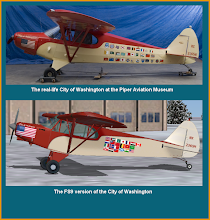LEG 8 - PRESQUE ISLE TO GOOSE BAY
This so far was the longest leg of the journey, but there are longer leg, yet - so at 1930Z I checked the weather in northern Maine (yep it's still cold as heck), loaded 50 gallons of the good stuff at New England Flight Support, Crown of Maine Office, taxied The City of Washington out to Runway 1, and was airborne by 2017Z. This would be a long flight and over some fairly barren landscape, so I decided to fly a bit higher than usual and leveled off at 7500 MSL on amagnetic rhumbline of 057.
Lucky me the autopilot wasn't acting up and we hummed along nicely for almost four hours before I noticed a gradual change in the terrain. Looking at the sectional it seemed to me that I was a bit west of course, veering closer to Churchill Falls than Goose Bay, which was confirmed with the ADF pointing out that the Churchill Falls NDB was over that-a-way. A few minutes later the Wabush VOR started ditting and dahing, and within a few minutes I had a fix: 68 miles west of planned track after 366 nm. Well there's still plenty of time and enough fuel, so using the 1-in-60 rule of thumb I calculated a new course of 097 to Goose Bay, turned on course, tuned in to the Goose Bay VOR and waited. Here, from my log:
0000Z - waiting
0005Z - waiting, wondering if I should make extra correction for winds - nah - I'm pretty close.
0030Z - waiting, wondering if I should have made a correction for winds on this leg. Skies clearing. 2300 RPM.
0100Z - I ought to be getting closer - it's been about an hour...waiting for VOR or NDB indicators. I wonder if I should have made a correction for wind on this leg.
This went on some time, as I monitored the engines and autopilot, until:
"da da dit da, da da dit da, dit da dit" - the VOR! the VOR! Yay!
0111Z - picked up Goose Bay on 117.3. Heading of 100 is very close to calculated 1-in-60 heading of 097.
0138Z - picked up the Goose Bay NDB on 257 KHz.
ATIS indicates calm winds, RWY 8 in use - bonus! Arrived at 0220Z, and tied down at Avalon Flight Center - Labrador. 3 gallons of fuel remaining.
-
For more on how to make enroute track error adjusments, see:
here


















